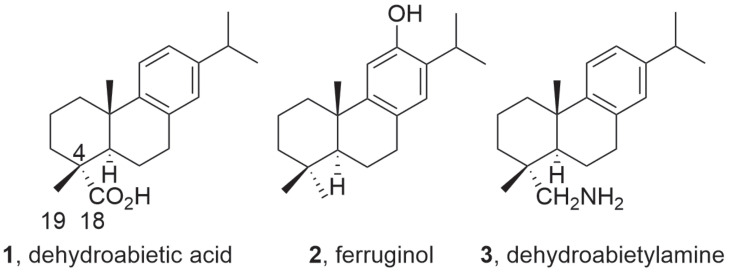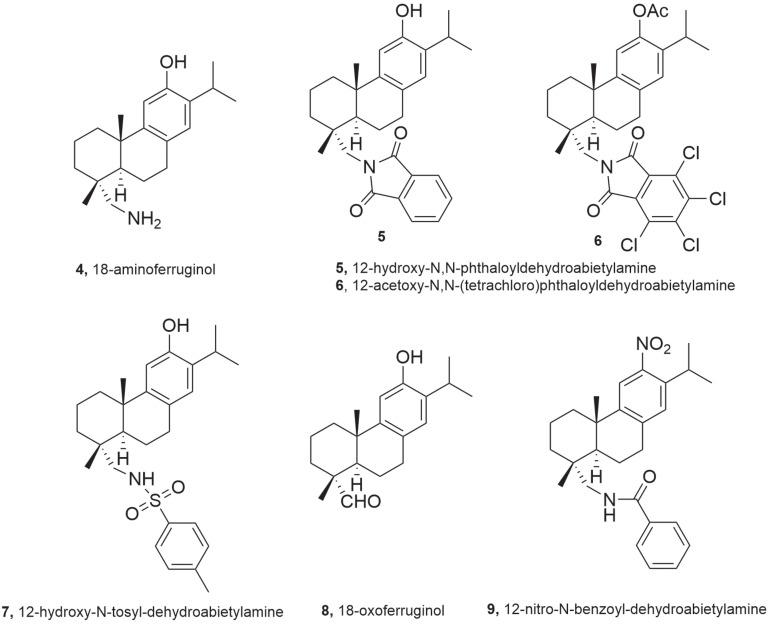ABSTRACT
Abietane diterpenoids are naturally occurring plant metabolites with a broad spectrum of biological effects including antibacterial, antileishmanial, antitumor, antioxidant, as well as antiinflammatory activities. Recently, we found that some analogues of natural ferruginol ( 2 ) actively inhibited dengue virus 2 (DENV-2) replication. Due to the similarity with DENV, we envisaged that abietane diterpenoids would also be active against Zika virus (ZIKV). Six selected semi-synthetic abietane derivatives of (+)-dehydroabietylamine ( 3 ) were tested. Cytotoxicity was determined by MTT assay in Vero cells. In vitro anti-ZIKV (clinical isolate, IMT17) activity was evaluated by plaque assay. Interestingly, these molecules showed potential as anti-ZIKV agents, with EC50 values ranging from 0.67 to 18.57 µM, and cytotoxicity (CC50 values) from 2.56 to 35.09 µM. The 18-Oxoferruginol (8) (EC50 = 2.60 µM, SI = 13.51) and 12-nitro-N-benzoyldehydroabietylamine (9) (EC50= 0.67 µM, SI = 3.82) were the most active compounds, followed by 12-hydroxy-N-tosyldehydroabietylamine ( 7 ) (EC50 = 3.58 µM, SI = 3.20) and 12-hydroxy-N,N-phthaloyldehydroabietylamine ( 5 ) (EC50 = 7.76 µM, SI = 1.23). To the best of our knowledge, this is the first report on anti-Zika virus properties of abietanes.
KEYWORDS: Zika, Abietane, Diterpenoid, Semi-synthesis, Anti-ZIKV activity
Zika virus (ZIKV) is an arbovirus of the Flaviviridae family, phylogenetically close to dengue virus and yellow fever. Zika virus is mainly transmitted by Aedes mosquitoes and usually causes a mild dengue-like illness that may include fever, cutaneous rash, malaise, headache, muscle and joint pain, and/or swollen lymph nodes. Neurological complications include Guillain–Barré syndrome and congenital malformations leading to microcephaly 1 . Although Zika virus outbreaks have declined after 2017, autochthonous transmission of ZIKV still occurs globally across at least 87 countries and territories, with the potential for re-emergence 2 . Since specific antiviral drugs or vaccines are not available, there is urgency in identifying antiviral agents, particularly new molecular scaffolds with potential novel mechanisms of actions.
Natural products have played a dominant role in the drug discovery efforts for the treatment of human diseases 3 . In fact, in 2015, small molecules accounted for 45 drugs as antivirals other than synthetic molecules or 70% overall based on natural products, indicating the potential of identifying new therapeutic candidates from natural sources 3 . The abietane diterpenoids are widely produced by conifers and plants belonging to the families Araucariaceae, Cupressaceae, Pinaceae, Podocarpaceae, and angiosperm species 4 . These natural products have a wide range of biological activities 5 . For example, dehydroabietic acid ( 1 , DHA) ( Figure 1 ), displays not only antiulcer and antimicrobial properties, but also antitumor effects. Ferruginol ( 2 ) ( Figure 1 ) was first isolated in 1939 and has been extensively studied because of intriguing chemical framework and promising biological properties 6 . Ferruginol ( 2 ) occurs in plants belonging to the Podocarpaceae, Cupressaceae, Lamiaceae and Verbenaceae families among others. This diterpene exhibited important bioactivities, such as antifungal and antimicrobial, miticidal, cardioactive, antioxidative, antileishmanial and nematicidal, antiulcer, and anti-SARS properties 5 . In addition, there are several reports on antimalarial activity of ferruginol ( 2 ) 7 . Recently, it has been reported that several antimalarials are endowed with anti-DENV and anti-ZIKV activities 8 . We have also found that some analogues derived from (+)-dehydroabietylamine ( 3 ) ( Figure 1 ) of the naturally occurring abietane ferruginol ( 2 ) ( Figure 1 ) were active against DENV-2 9 . The 12-hydroxyabieta-8,11,13-triene skeleton, which is characteristic of the diterpenoid ferruginol ( 2 ), is therefore an interesting molecular scaffold for the development of novel antivirals against flaviviruses.
Figure 1. Some typical bioactive abietane-type diterpenoids.
To explore the potential of some selected analogues of ferruginol ( 2 ) as antiviral candidates, and in continuation of our research programs to discover bioactive terpenoids, herein we report the evaluation of previously synthesized semisynthetic derivatives 4 – 9 9 – 11 from the commercially available (+)-dehydroabietylamine ( 3 ) ( Figure 1 ) against a Brazilian strain of ZIKV.
The compounds were obtained in enantiomerically pure form from commercially available (+)-dehydroabietylamine ( 3 ) ( Figure 1 ) according to our previously reported synthetic procedures 9 – 11 . The generated analogues are named as follows: 12-hydroxy-dehydroabietylamine (18-aminoferruginol, 4 ), 12-hydroxy-N,N-phthaloyldehydroabietylamine ( 5 ), 12-acetoxy-N,N-(tetrachlorophthaloyl)dehydroabietylamine ( 6 ), 12-hydroxy-N-tosyldehydroabietylamine ( 7 ), 18-oxoferruginol ( 8 ) and 12-nitro-N-benzoyldehydroabietylamine ( 9 ). Stock solutions of the tested compounds were prepared in dimethyl sulfoxide (DMSO) and maintained at –20 °C until use.
The cytotoxicity of the ferruginol analogues 4 – 9 ( Figure 2 ) was assessed on Vero cells (African green monkey kidney) by the MTT (3-(4,5-dimethylthiazol-2-yl)-2,5-diphenyltetrazolium bromide) assay 12 . Vero cells suspensions (2.7 × 105 cells/mL) prepared in MEM (Minimal Essential Medium, Vitrocell) with 5% Fetal Bovine Serum (FBS, Gibco, Sao Paulo, Brazil) were distributed in 96-well plates (100 μL/well) and incubated at 37 °C (5% CO2) for 24 h. Then, the culture medium was replaced by 200 μL of two-fold serial dilutions of the compounds or DMSO. Cellular controls were treated with the culture medium only. After treatments, plates were further incubated at 37 °C for 4 days. Subsequently, 15 μL of the MTT solution (5 mg/mL) were added per well, and the plates were incubated again for 4 h. The MTT solution was removed and 100 μL of DMSO were added to dissolve formazan crystals. Finally, the plates were shaken and absorbance was read at 540 nm. The viability percentage data for each tested concentration of the compounds were entered in the GraphPad Prism software (version 5.01, San Diego, California, USA) to calculate the CC50 values, the concentration of compound that causes a 50% reduction in cell viability, through regression analysis.
Figure 2. Abietane analogues selected to test anti-Zika virus activity.
Zika virus (clinical isolate, IMT17) stock was produced and titrated in Vero cells. The viral titer, 4.67 × 106 plaque forming units per milliliter (PFU/mL), was determined by plaque assay 13 . The potential anti-ZIKV activity was evaluated by viral plaque reduction assay. Briefly, Vero cells (1.5 × 105 cells/well) were grown in 24-well plates for 24 h. After that, cells were infected with 100 PFU/well and incubated for 1 h in a humidified 37 °C incubator with 5% CO2. Cells were then washed with PBS (pH 7.0) and treated with different concentrations of each compound [diluted in 2 X MEM with 2% FBS and 50% high viscosity carboxymethyl cellulose (CMC, Sigma)]. Ribavirin was used as the positive control. Medium only and DMSO were used as untreated and solvent controls, respectively. After 4 days of incubation at 37 °C, 5% CO2, supernatants were removed, and cells were fixed and stained with 50% crystal violet in 50% ethanol. Plaque numbers were used to calculate the inhibition percentage values in order to determine the EC50, the concentration of the compound that inhibits viral replication by 50%, through non-linear regression analysis using the GraphPad Prism. Compounds efficacy was determined by the selectivity index (SI = CC50 / EC50), the ratio between cytotoxicity and antiviral activity.
Cytotoxicity and antiviral assay results of the compounds 4-9 are shown in Table 1 . The 12-Nitro-N-benzoyldehydroabietylamine ( 9 ) (EC50= 0.67 µM, SI = 3.82 and EC90= 0.89 ± 0.004 µM) and 18-oxoferruginol ( 8 ) (EC50 = 2.60 µM, SI = 13.51 and EC90 = 20.79 ± 3.75 µM) were the most active antiviral compounds, followed by 12-hydroxy-N-tosyldehydroabietylamine ( 7 ) (EC50 = 3.58 µM, SI= 3.20) and 12-hydroxy-N,N-phthaloyldehydroabietylamine ( 5 ) (EC50= 7.76 µM, SI = 1.23).
Table 1. Cytotoxicity and anti-ZIKV activity of compounds 4-9.
| Compound | Cytotoxicity | Anti-ZIKV activity | SI c |
|---|---|---|---|
| CC50 a (μM) | EC50 b (μM) | ||
| 4 | 28.33±3.44 | 18.57±1.00 | 1.53 |
| 5 | 9.51±0.76 | 7.76±0.74 | 1.23 |
| 6 | 34.04±7.35 | 11.52±0.08 | 2.95 |
| 7 | 11.46±1.95 | 3.58±0.59 | 3.20 |
| 8 | 35.09±5.20 | 2.60±0.07 | 13.51 |
| 9 | 2.56±0.45 | 0.67±0.07 | 3.82 |
| Ribavirin | 2,586.50±318.91 | 98.53±6.46 | 26.25 |
Values represent the means ± SD of at least two independent experiments;
CC50 = 50% cytotoxic concentration on Vero cells;
EC50 (µM) = 50% effective concentration against ZIKV replication by plaque assay;
Selectivity index (SI): ratio between cytotoxicity and antiviral activity (CC50/EC50).
Inhibitory values against Zika virus ranged from 0.67 to 18.57 µM, with cytotoxicity properties varying from 2.56 to 35.09 µM. All compounds presented EC50 values lower than the reference ribavirin (EC50= 98.53 µM), although ribavirin displayed a higher SI value (26.25). The resulting experimental data indicate that nitro derivative ( 9 ) displayed potent antiviral activity but possess a certain cytotoxicity. Compound 18-oxoferruginol ( 8 ) presented the most promising results with a higher selectivity index (SI = 13.51). According to Chattopadhyay et al . 14 a SI of 10 or greater is indicative of a promising antiviral activity. Therefore, it has been demonstrated that abietane-derived compounds represent a novel scaffold for the development of anti-Zika virus agents. To the best of our knowledge, this is the first report on anti-ZIKV activity of abietane-type diterpenoids. These encouraging findings warrant synthetic endeavors to get structure-activity relationships, as well as further mechanism of action and target identification studies.
Footnotes
FUNDING
Financial support from the Universitat Politècnica de Valencia, under a cooperation “ADSIDEO” research grant (AD1902), is gratefully acknowledged. We are also gratefully to the financial support of the Sao Paulo Research Foundation (FAPESP), grants N° 2013/01690-0, N° 2019/03859-9, and FAPESP Scholarship N° 2013/01702-9 to FTGS.
REFERENCES
- 1.Noorbakhsh F, Abdolmohammadi K, Fatahi Y, Dalili H, Rasoolinejad M, Rezaei F, et al. Zika virus infection, basic and clinical aspects: a review article. Iran J Public Health. 2019;48:20–31. [PMC free article] [PubMed] [Google Scholar]
- 2.World Health Organization Countries and territories with current or previous Zika virus transmission, by WHO regional office. [[cited 2020 Nov 17]]. Available from: https://www.who.int/emergencies/diseases/zika/countries-with-zika-and-vectors-table.pdf.
- 3.Newman DJ, Cragg GM. Natural products as sources of new drugs over the nearly four decades from 01/1981 to 09/2019. J Nat Prod. 2020;83:770–803. doi: 10.1021/acs.jnatprod.9b01285. [DOI] [PubMed] [Google Scholar]
- 4.Hanson JR, Nichols T, Mukhrish Y, Bagley MC. Diterpenoids of terrestrial origin. Nat Prod Rep. 2019;36:1499–1512. doi: 10.1039/c8np00079d. [DOI] [PubMed] [Google Scholar]
- 5.González MA. Aromatic abietane diterpenoids: their biological activity and synthesis. Nat Prod Rep. 2015;32:684–704. doi: 10.1039/c4np00110a. [DOI] [PubMed] [Google Scholar]
- 6.Brandt CW, Neubauer LG. Miro resin. Part I. Ferruginol. J Chem Soc. 1939:1031–1037. [Google Scholar]
- 7.González MA, Clark J, Connelly M, Rivas F. Antimalarial activity of abietane ferruginol analogues possessing a phthalimide group. Bioorg Med Chem Lett. 2014;24:5234–5237. doi: 10.1016/j.bmcl.2014.09.061. [DOI] [PubMed] [Google Scholar]
- 8.Balasubramanian A, Teramoto T, Kulkarni AA, Bhattacharjee AK, Padmanabhan R. Antiviral activities of selected antimalarials against dengue virus type 2 and Zika virus. Antivir Res. 2017;137:141–150. doi: 10.1016/j.antiviral.2016.11.015. [DOI] [PubMed] [Google Scholar]
- 9.Roa-Linares VC, Brand YM, Agudelo-Gomez LS, Tangarife-Castaño V, Betancur-Galvis LA, Gallego-Gomez JC, et al. Anti-herpetic and anti-dengue activity of abietane ferruginol analogues synthesized from (+)-dehydroabietylamine. Eur J Med Chem. 2016;108:79–88. doi: 10.1016/j.ejmech.2015.11.009. [DOI] [PMC free article] [PubMed] [Google Scholar]
- 10.González MA, Pérez-Guaita D. Short syntheses of (+)-ferruginol from (+)-dehydroabietylamine. Tetrahedron. 2012;68:9612–9615. [Google Scholar]
- 11.Dea-Ayuela MA, Bilbao-Ramos P, Bolás-Fernández F, González-Cardenete MA. Synthesis and antileishmanial activity of C7- and C12-functionalized dehydroabietylamine derivatives. Eur J Med Chem. 2016;121:445–450. doi: 10.1016/j.ejmech.2016.06.004. [DOI] [PubMed] [Google Scholar]
- 12.Cory AH, Owen TC, Barltrop JA, Cory JG. Use of an aqueous soluble tetrazolium/formazan assay for cell growth assays in culture. Cancer Commun. 1991;3:207–212. doi: 10.3727/095535491820873191. [DOI] [PubMed] [Google Scholar]
- 13.Burleson FG, Chambers TM, Wiedbrauk DL. Virology: a laboratory manual. San Diego: Academic Press; 1992. [Google Scholar]
- 14.Chattopadhyay D, Sarkar MC, Chatterjee T, Sharma Dey R, Bag P, Chakraborti S, et al. Recent advancements for the evaluation of anti-viral activities of natural products. N Biotechnol. 2009;25:347–368. doi: 10.1016/j.nbt.2009.03.007. [DOI] [PMC free article] [PubMed] [Google Scholar]




